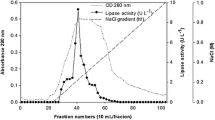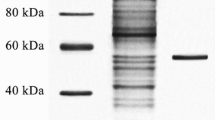Abstract
A halophilic strain W33 showing lipolytic activity was isolated from the saline soil of Yuncheng Salt Lake, China. Biochemical and physiological characterization along with 16S rRNA gene sequence analysis placed the isolate in the genus Idiomarina. The extracellular lipase was purified to homogeneity by 75 % ammonium sulphate precipitation, DEAE-Sepharose anion exchange and Sephacryl S-200 gel filtration chromatography. The molecular mass of the purified lipase was estimated to be 67 kDa by SDS-PAGE. Substrate specificity test indicated that it preferred long-chain p-nitrophenyl esters. Optimal lipase activity was found to be at 60 °C, pH 7.0–9.0 and 10 % NaCl, and it was highly active and stable over broad temperature (30–90 °C), pH (7.0–11.0) and NaCl concentration (0–25 %) ranges, showing excellent thermostable, alkali-stable and halotolerant properties. Significant inhibition by diethyl pyrocarbonate and phenylarsine oxide was observed, implying histidine and cysteine residues were essential for enzyme catalysis. In addition, the lipase displayed high stability and activity in the presence of hydrophobic organic solvents with log P ow ≥ 2.13. The free and immobilized lipases produced by Idiomarina sp. W33 were applied for biodiesel production using Jatropha oil, and about 84 and 91 % of yields were achieved, respectively. This study formed the basic trials conducted to test the feasibility of using lipases from halophile for biodiesel production.





Similar content being viewed by others
References
Abdulla R, Chan ES, Ravindra P (2011) Biodiesel production from Jatropha curcas: a critical review. Crit Rev Biotechnol 31:53–64
Amoozegar MA, Malekzadeh F, Malik KA (2003) Production of amylase by newly isolated moderate halophile, Halobacillus sp. strain MA-2. J Microbiol Methods 52:353–359
Antczak MS, Kubiak A, Antczak T, Bielecki S (2009) Enzymatic biodiesel synthesis-key factors affecting efficiency of the process. Renew Energ 34:1185–1194
Azocar L, Ciudad G, Heipieper HJ, Navia R (2010) Biotechnological processes for biodiesel production using alternative oils. Appl Microbiol Biotechnol 88:621–636
Boutaiba S, Bhatnagar T, Hacene H, Mitchell DA, Baratti JC (2006) Preliminary characterization of a lipolytic activity from an extremely halophilic archaeon, Natronococcus sp. J Mol Catal B Enzym 41:21–26
Bradford MM (1976) A rapid and sensitive method for the quantification of microgram quantities of protein utilizing the principle of protein-dye binding. Anal Biochem 72:248–254
Camacho RM, Mateos JC, González-Reynoso O, Prado LA, Córdova J (2009) Production and characterization of esterase and lipase from Haloarcula marismortui. J Ind Microbiol Biotechnol 36:901–909
Chakraborty S, Khopade A, Biao R, Jian W, Liu XY, Mahadik K, Chopade B, Zhang LX, Kokare C (2011) Characterization and stability studies on surfactant, detergent and oxidant stable α-amylase from marine haloalkaliphilic Saccharopolyspora sp. A9. J Mol Catal B Enzym 68:52–58
Coronado M, Vargas C, Hofemeister J, Ventosa A, Nieto JJ (2000) Production and biochemical characterization of an alpha-amylase from the moderate halophile Halomonas meridiana. FEMS Microbiol Lett 183:67–71
Daoud L, Kamoun J, Ali MB, Jallouli R, Bradai R, Mechichi T, Gargouri Y, Ali YB, Aloulou A (2013) Purification and biochemical characterization of a halotolerant Staphylococcus sp. extracellular lipase. Int J Biol Macromol 57:232–237
Dheeman DS, Frias JM, Henehan GT (2010) Influence of cultivation conditions on the production of a thermostable extracellular lipase from Amycolatopsis mediterranei DSM 43304. J Ind Microbiol Biotechnol 37:1–17
Dheeman DS, Antony-Babu S, Frias JM, Henehan GTM (2011) Purification and characterization of an extracellular lipase from a novel strain Penicillium sp. DS-39 (DSM 23773). J Mol Catal B Enzym 72:256–262
Doukyu N, Ogino H (2010) Organic solvent tolerant enzymes. Biochem Eng J 48:270–282
Gupta R, Gupta N, Rathi P (2004) Bacterial lipases: an overview of production, purification and biochemical properties. Appl Microbiol Biotechnol 64:763–781
Hough DW, Danson DJ (1999) Extremozymes. Curr Opin Chem Biol 3:39–46
Jaeger KE, Dijkstra BW, Reetz MT (1999) Bacterial biocatalysts: molecular biology, three-dimensional structures, and biotechnological applications of lipases. Ann Rev Microbiol 53:315–351
Janssen PH, Monk CR, Morgan HW (1994) A thermophilic, lipolytic Bacillus sp., and continuous assay of its p-nitrophenyl-palmitate esterase activity. FEMS Microbiol Lett 120:195–200
Ji Q, Xiao S, He B, Liu X (2010) Purification and characterization of an organic solvent-tolerant lipase from Pseudomonas aeruginosa LX1 and its application for biodiesel production. J Mol Catal B Enzym 66:264–269
Kawakami K, Oda Y, Takahashi R (2011) Application of a Burkholderia cepacia lipase-immobilized silica monolith to batch and continuous biodiesel production with a stoichiometric mixture of methanol and crude Jatropha oil. Biotechnol Biofuels 4:42
Kushner D, Kamekura M (1988) Physiology of halophilic eubacteria. In: Rodriguez-Valera F (ed) Halophilic Bacteria. CRC Press, Boca Raton, pp 109–138
Laemmli UK (1970) Cleavage of structural proteins during the assembly of the head of bacteriophage T4. Nature 227:680–685
Lima VMG, Krieger N, Mitchell DA, Fontana JD (2004) Activity and stability of a crude lipase from Penicillium aurantiogriseum in aqueous media and organic solvents. Biochem Eng J 18:65–71
Margesin R, Schinner F (2011) Potential of halotolerant and halophilic microorganisms for biotechnology. Extremophiles 5:73–83
Mevarech M, Frolow F, Gloss LM (2000) Halophilic enzymes: proteins with a grain of salt. Biophys Chem 86:155–164
Noureddini H, Gao X, Philkana RS (2005) Immobilized Pseudomonas cepacia lipase for biodiesel fuel production from soybean oil. Bioresour Technol 96:769–777
Ozcan B, Ozyilmaz G, Cokmus C, Caliskan M (2009) Characterization of extracellular esterase and lipase activities from five halophilic archaeal strains. J Ind Microbiol Biotech 36:105–110
Pérez D, Martín S, Fernández-Lorente G, Filice M, Guisán JM, Ventosa A, Mellado E (2011) A novel halophilic lipase, LipBL, showing high efficiency in the production of eicosapentaenoic acid (EPA). PLoS One 6:e23325
Rahman RN, Baharum SN, Basri M, Salleh AB (2005) High-yield purification of an organic solvent-tolerant lipase from Pseudomonas sp. strain S5. Anal Biochem 341:267–274
Rathi P, Bradoo S, Saxena RK, Gupta R (2000) A hyper-thermostable, alkaline lipase from Pseudomonas sp. with the property of thermal activation. Biotechnol Lett 22(6):495–498
Rúa L, Díaz-Mauriño T, Fernández VM, Otero C, Ballesteros A (1993) Purification and characterization of two distinct lipases from Candida cylindracea. Biochim Biophys Acta 1156:181–189
Sellek GA, Chaudhuri JB (1999) Biocatalysis in organic media using enzymes from extremophiles. Enzyme Microb Technol 25:471–482
Shah S, Gupta MN (2007) Lipase catalyzed preparation of biodiesel from Jatropha oil in a solvent free system. Process Biochem 42:409–414
Sivaramakrishnan R, Muthukumar K (2012) Isolation of thermo-stable and solvent-tolerant Bacillus sp. lipase for the production of biodiesel. Appl Biochem Biotechnol 166:1095–1111
Teo JWP, Zhang LH, Poh CL (2003) Cloning and characterization of a novel lipase from Vibrio harveyi strain AP6. Gene 312:181–188
Van den Burg B (2003) Extremophiles as a source for novel enzymes. Curr Opin Microbiol 6:213–218
Winkler UK, Stuckmann M (1979) Glycogen, hyaluronate, and some other polysaccharides greatly enhance the formation of exolipase by Serratia marcescens. J Bacteriol 138:663–670
Yu XW, Sha C, Guo YL, Xiao R, Xu Y (2013) High-level expression and characterization of a chimeric lipase from Rhizopus oryzae for biodiesel production. Biotechnol Biofuels 6:29
Acknowledgments
This work was financially supported by National Natural Science Foundation of China (Grants No. 31300002), Natural Science Fund of Shanxi Province (Grants No. 2011021031-4) and PhD Start-up Foundation of Yuncheng University (Grants No. YQ-2011043).
Author information
Authors and Affiliations
Corresponding author
Additional information
Communicated by L. Huang.
Rights and permissions
About this article
Cite this article
Li, X., Qian, P., Wu, SG. et al. Characterization of an organic solvent-tolerant lipase from Idiomarina sp. W33 and its application for biodiesel production using Jatropha oil. Extremophiles 18, 171–178 (2014). https://doi.org/10.1007/s00792-013-0610-0
Received:
Accepted:
Published:
Issue Date:
DOI: https://doi.org/10.1007/s00792-013-0610-0




